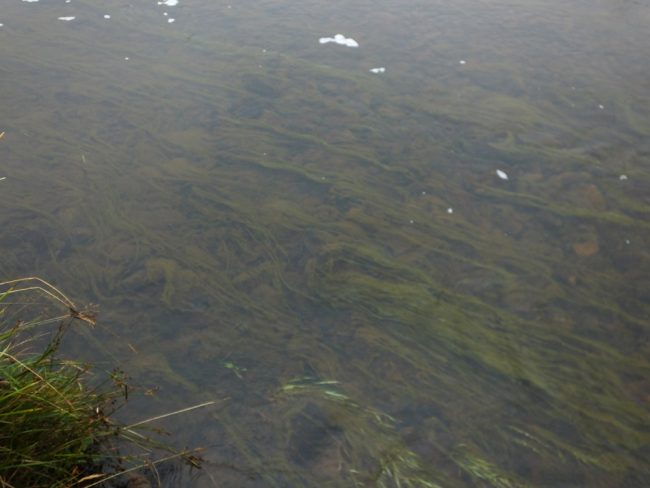We’ve been planning to perform experimental gravel cleaning on a few sites on the Ayr that are affected by siltation or enrichment. The aim will be to see if by removing the fine sediments that choke the spawning beds, whether we can increase egg survival and increase fry numbers.

Typical of the enriched habitat we find in the upper Ayr catchment where high conductivity levels indicate excessive nutrients that lead to algal growth such as this. Unfortunately, this algae smothers the spawning substrates and traps finer sediments, we believe causing productivity to plummet
SEPA requested we monitor these site using semi quantitative methods both before and after to allow a proper assessment of the results. We’ve been doing this for a couple of years now but so far, water levels haven’t allowed us into the river at the back end to clean the gravel but hopefully we will manage this in the next week or two before fish start spawning or high winter flows prevent us.
The team were out surveying gravel cleaning sites on the Ayr today and as soon as we finish our other obligations, we hope to commence cleaning. It will be a very interesting study to see if we can improve spawning success and egg survival but we won’t know this until we repeat the surveys next summer and compare these with other control sites and previous results.

Struan on the anode under the watchful eye of Muir. There’s no substitute for hands on experience when electrofishing and keeping the fish safe and alive is paramount to success. In super high conductive water such as we found at this site, it would be very easy to kill juvenile salmonids if the equipment wasn’t set up correctly and the fish response monitored
Struan was getting experience of setting up and leading a team of electrofishers. Struan’s helped the Trust with electrofishing for as long as I can remember (at least as far back as 2006). He’s been trained to basic electrofishing standards and is very able and competent as a team member but next year he will go forwards for team leader. Normally it takes two years following the introductory course (which he passed this year) but as he has years of experience, we are happy to push him on if the powers that be in SFCC agree. I think given his experience, I hope they will make an exception. Interestingly, his comments today indicated that he felt there was quite a difference between fishing as part of a team and being in control of the anode, survey, fish welfare and team safety. At least under the supervision of two team leaders, he will get every opportunity to learn the techniques we use and qualify in due course.

